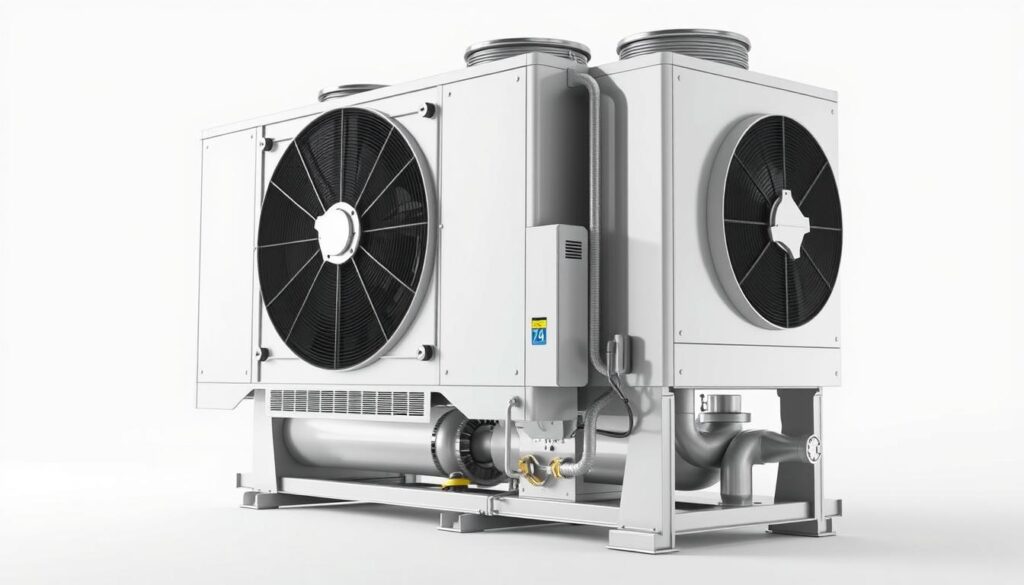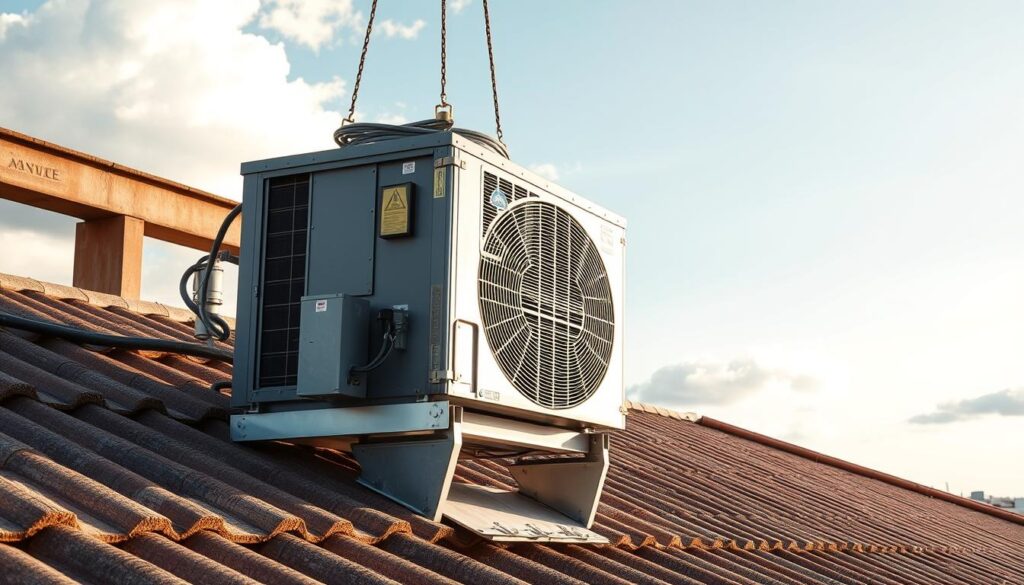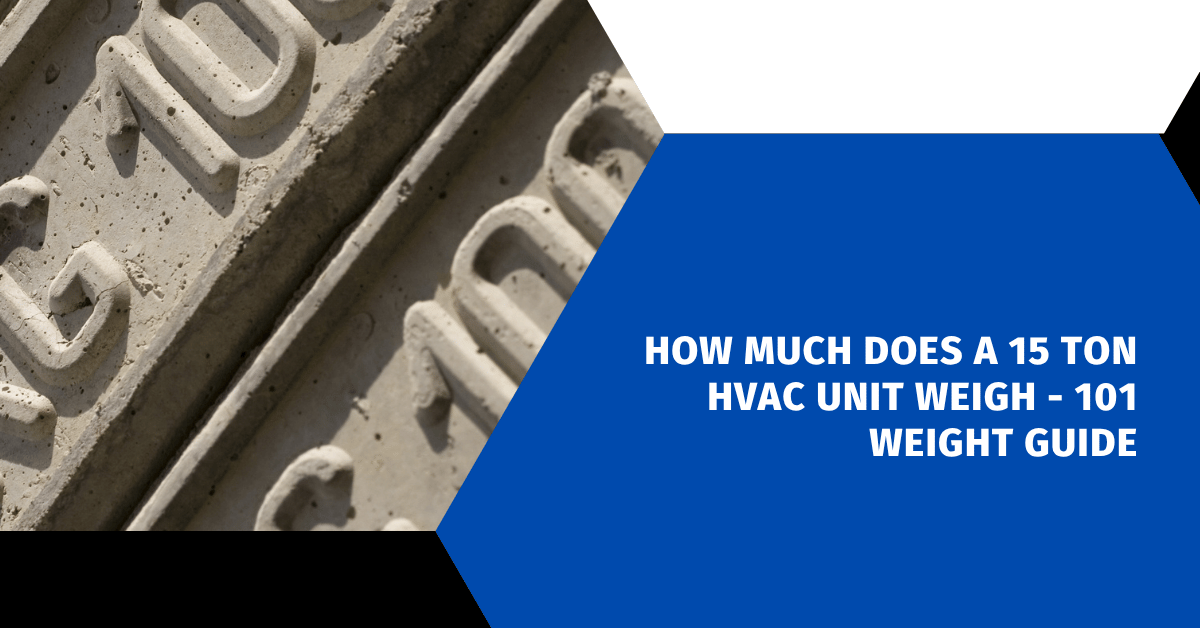Affiliate Disclosure
HVAC Guide Guys is a participant in the Amazon Services LLC Associates Program, an affiliate advertising program designed to provide a means for sites to earn advertising fees by advertising and linking to Amazon.
How Much Does a 15 Ton HVAC Unit Weigh? Ever wondered how to support a huge 15-ton HVAC unit on your commercial building’s roof? Knowing the weight of an HVAC unit is key for building managers. With a 15-ton system, every pound is important for safety, moving, and setting up.

The weight of an HVAC unit affects your building’s structure and setup. A 15-ton unit is a big investment that needs careful planning and weight attention. Knowing the exact weight can make or break a successful setup.
This guide will cover everything about a 15-ton HVAC unit’s weight. We’ll look at structural needs, moving issues, and more. We’ll explain the important factors that affect your commercial HVAC system’s total weight.
Key Takeaways
- 15-ton HVAC units have complex weight specifications
- Structural support is key for proper installation
- Weight affects moving and mounting needs
- Different makers have different unit weights
- Getting a pro’s opinion is vital before setting up
Table of Contents
Understanding Commercial HVAC Unit Weights
When looking at commercial HVAC units, knowing their weight is key. This is because the weight changes based on many factors. It’s important to know what makes up the weight and what to consider.
Commercial HVAC units are complex. They have many parts that add to their weight. These parts affect how well the unit works and what it needs structurally.
Basic Weight Components
The main parts that make up the weight of commercial HVAC units are:
- Compressor: The heaviest single part
- Condenser coils: They add a lot to the weight
- Fan motors: These motors also add a lot of weight
- External housing: This is the unit’s structure
- Refrigerant lines: These lines add to the weight too
Factors Affecting Total Weight
Several things can change the total weight of commercial HVAC units:
- What kind of refrigerant is used and how much
- The materials used in making the unit
- Any extra features added to the unit
- The unit’s cooling power
- The design by the manufacturer
Standard Weight Ranges
Commercial HVAC unit weights can vary a lot. Here’s a general idea of what to expect:
| Unit Size | Weight Range | Typical Application |
|---|---|---|
| 5-10 Ton | 500-1,200 lbs | Small commercial spaces |
| 10-15 Ton | 1,200-2,500 lbs | Medium commercial buildings |
| 15-20 Ton | 2,500-3,500 lbs | Large commercial facilities |
Knowing these weight ranges helps with planning for installing and maintaining commercial HVAC units.
How Much Does a 15 Ton HVAC Unit Weigh
Exploring the weight of a 15 ton HVAC unit shows it can vary a lot. A typical 15 ton unit weighs between 1,200 to 1,800 pounds. This makes it a big piece of equipment for cooling.
The weight of an HVAC unit depends on many parts. These parts include the compressor, condenser coils, metal housing, and electrical parts. The materials and design used by the manufacturer also play a big role in the unit’s weight.
- Compressor weight: 400-600 pounds
- Condenser coils: 250-350 pounds
- Metal housing and framework: 300-500 pounds
- Electrical components: 150-250 pounds
To understand the weight of a 15 ton HVAC unit, look at the manufacturer’s specs. These systems are not all the same. The weight can change based on how complex the design is.
| Manufacturer | Average Weight | Weight Range |
|---|---|---|
| Carrier | 1,450 lbs | 1,350-1,550 lbs |
| Trane | 1,500 lbs | 1,400-1,600 lbs |
| York | 1,375 lbs | 1,300-1,450 lbs |
When you’re planning to install a 15 ton HVAC unit, always check the manufacturer’s details. This will give you the exact weight for your model.
Explore Our HVAC Shop
Looking for top-rated HVAC tools, parts, and accessories? Visit our shop and find the perfect solution for your needs.
Visit the ShopDimensional Specifications of 15 Ton Units
When planning to install commercial HVAC units, knowing the exact size is key. The size of a 15-ton HVAC system affects where it can go and what it needs structurally.
Good planning is essential for installing commercial HVAC units right. Knowing the exact size helps architects, engineers, and facility managers make smart choices.
Length and Width Measurements
15-ton commercial HVAC units vary in size, depending on the maker. These sizes are important for planning the space:
- Average length: 90-120 inches
- Average width: 60-84 inches
- Typical depth: 36-48 inches
Height and Clearance Requirements
Height is also important for installing HVAC units. You need to think about:
- Minimum overhead clearance
- Mounting surface strength
- Ventilation space
Installation Space Considerations
| Space Type | Recommended Clearance |
|---|---|
| Side Ventilation | 24-36 inches |
| Top Access | 48-60 inches |
| Maintenance Pathway | 36-42 inches |
Remember that precise measurements can vary based on specific unit design and manufacturer recommendations.
Weight Distribution and Structural Requirements

Knowing the weight of your HVAC equipment is key for safe and effective installation. Your 15-ton HVAC unit needs careful planning for proper weight distribution. This ensures it fits well with your building’s structure.
How you distribute the weight affects your HVAC system’s performance and lifespan. Different setups require different structural considerations:
- Rooftop installations need strong support platforms
- Ground-level units need solid concrete foundations
- It’s important to check your building’s load-bearing capacity
For the installation of your HVAC, engineers suggest several strategies:
- Do a detailed structural analysis before you start
- Use top-notch mounting brackets
- Use technologies to reduce vibrations
- Spread the weight evenly on the support surfaces
“Proper weight distribution is not just about supporting the equipment, but maintaining long-term structural integrity.” – HVAC Engineering Professionals
Getting a professional assessment is vital to avoid structural damage and ensure your system works its best.
Explore Our HVAC Shop
Looking for top-rated HVAC tools, parts, and accessories? Visit our shop and find the perfect solution for your needs.
Visit the ShopTransportation and Lifting Requirements
Moving a 15-ton HVAC unit needs special skills and careful planning. It’s a big job that requires precise knowledge and safety steps.
When moving your HVAC unit, many important things need to be considered. Experts must look at several key points to make sure the move is safe and goes well.
Crane Specifications for Heavy Lifting
Choosing the right crane is key for moving heavy equipment. You should think about:
- Crane must be able to lift more than 15 tons
- Boom length should fit the installation site
- Crane needs to be hydraulic with precise controls
- Equipment must be certified for industrial use
Essential Safety Protocols
Safety is the top priority when moving HVAC units. Experts must follow strict safety steps:
- Do a full check on the equipment before lifting
- Make sure the ground is stable and the lifting area is safe
- Use only certified rigging gear
- Have clear communication among team members
- Keep the fewest people in the lifting area
Required Transportation Equipment
The team moving your HVAC unit will need special gear for safety:
- Heavy-duty flatbed trucks
- Special rigging straps
- Platforms that absorb shock
- Tools to keep the load in place
- Protective gear for workers
Good planning and execution are vital for moving HVAC units safely. This ensures the equipment arrives in good shape and installation goes smoothly.
Rooftop Installation Considerations

Installing rooftop air conditioning units needs careful planning. You must consider several important factors. These ensure the system is safely and efficiently placed.
Before installing rooftop air conditioning units, you need to look at a few key things:
- Roof structural integrity and load-bearing capacity
- Weight distribution of the HVAC unit
- Weatherproofing and sealing techniques
- Access routes for installation and maintenance
- Potential impact on existing roofing materials
Checking the roof’s structure is very important. You’ll need to work with a structural engineer. They will check if your building’s roof can handle a 15-ton unit. Some buildings might need extra support to handle the weight.
Weatherproofing is also key when installing rooftop air conditioning units. It stops water from getting in and protects the HVAC system and the building. Use top-quality waterproof membranes and make sure the unit is mounted correctly to avoid damage.
It’s also important to make sure there’s easy access for maintenance. This means leaving enough space around the unit. This way, technicians can do routine service and repairs safely and without problems.
Professional tip: Always consult with certified HVAC specialists. They can make sure your rooftop installation meets all local building codes and manufacturer specifications.
Commercial Building Load Calculations
Installing a 15-ton HVAC unit in a commercial building is a big deal. It’s all about making sure the building can handle it. This means looking at the weight and how the building is built.
Commercial cooling systems need careful planning to avoid damage. The process looks at many important factors. These factors affect how well the unit works and lasts.
Weight Load Assessment
When checking the weight, you need to look at two main things:
- Dead Load: This is the weight of the HVAC unit itself.
- Live Load: This includes the moving parts and people working on it.
Structural Support Requirements
Experts suggest a few steps to check if the building can support the unit:
- Do a detailed check of the building’s structure.
- See how much weight the roof or floor can hold.
- Find out if you need to add more support.
| Load Type | Weight Consideration | Potential Reinforcement |
|---|---|---|
| Static Load | 15-ton HVAC unit weight | Steel support brackets |
| Dynamic Load | Operational vibrations | Shock absorption systems |
| Maintenance Load | Technician movement | Additional structural reinforcement |
Getting help from experts is key. They make sure your building can safely hold a 15-ton HVAC unit. They do this by doing detailed calculations and planning the structure carefully.
Explore Our HVAC Shop
Looking for top-rated HVAC tools, parts, and accessories? Visit our shop and find the perfect solution for your needs.
Visit the ShopManufacturer Weight Variations
Choosing a 15-ton commercial HVAC unit shows that weight can differ a lot between makers. These differences come from design and engineering choices that affect how well the system works.
There are several important factors that make commercial HVAC units different:
- Material used in key parts
- Technology built into the unit
- How the unit is designed
- How it’s made strong
It’s key to understand these weight differences. Different makers might have 15-ton units that weigh 5-15% more or less. This depends on their design ideas.
When comparing what makers say, consider these points:
- Look at detailed weight info from the maker
- Check what support the unit needs
- See how strong the materials are
- Look at any extra tech added
Professional tip: Always ask for full spec sheets from makers. This helps get the exact weight needed for your project.
Getting the right weight is key for a good HVAC system and lasting performance.
Installation Equipment and Tools
Installing a 15-ton HVAC unit needs special tools and equipment. This ensures safe and efficient transport of heavy machinery. Your HVAC installation needs careful preparation and professional tools.
Professional HVAC technicians use specific tools and machinery for these big units. The right equipment helps avoid risks and makes the installation smoother.
- Crane or heavy-duty lifting equipment
- Forklift with minimum 15-ton capacity
- Rigging straps and load-bearing slings
- Precision leveling tools
- Torque wrenches
- Specialized HVAC connection tools
Your installation team must know a lot about heavy machinery transport. Safety is key when working with such big equipment.
| Equipment Category | Specific Tools | Purpose |
|---|---|---|
| Lifting Equipment | Hydraulic crane | Unit placement and positioning |
| Measurement Tools | Digital level | Precise unit alignment |
| Connection Tools | Refrigerant manifold gauges | System connectivity |
Professional preparation prevents installation problems and ensures the HVAC system works well.
Explore Our HVAC Shop
Looking for top-rated HVAC tools, parts, and accessories? Visit our shop and find the perfect solution for your needs.
Visit the ShopMaintenance Access Requirements
Maintaining large commercial HVAC units needs careful planning and precise access strategies. Technicians face complex weight distribution challenges during routine service and repairs. This is true for hvac installation requirements of 15-ton units.
Proper maintenance access is key for the longevity and performance of commercial hvac units. The weight and size of these systems pose unique challenges. They demand a specialized approach.
Service Clearance Considerations
Technicians need enough space to perform maintenance well. Recommended clearance includes:
- Minimum 3-4 feet of working space around all sides of the unit
- Clear vertical height for component removal
- Unobstructed pathways for equipment and tools
Weight Distribution During Maintenance
When servicing heavy commercial HVAC units, weight distribution is a big safety concern. Technicians must:
- Use specialized lifting equipment
- Carefully balance component weights
- Follow manufacturer-specific guidelines
Strategic planning ensures safe and efficient maintenance of these complex hvac installation requirements.
Conclusion
Knowing how much a 15 ton HVAC unit weighs is key for a successful install. Commercial HVAC units are big investments that need careful thought. How you handle weight affects the system’s efficiency, safety, and how long it lasts.
Weight is not just a number when looking at commercial HVAC units. It includes structural needs, moving it, and setting it up. Getting help from experts is vital. They can help with the weight issues for your building.
Before you install a 15 ton HVAC unit, check the building’s strength and space. Every commercial place has its own set of problems. With the right planning and expert advice, you can have a smooth and safe HVAC system.
The main point is: don’t overlook the weight of HVAC units. With the right prep, advice, and planning, you’ll get a reliable cooling system for your business.

